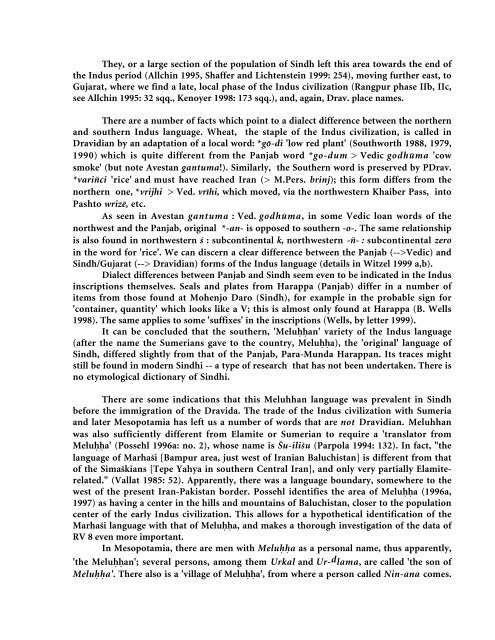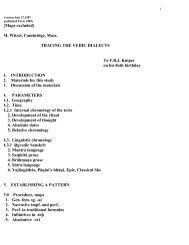The Languages of Harappa - People Fas Harvard
The Languages of Harappa - People Fas Harvard
The Languages of Harappa - People Fas Harvard
You also want an ePaper? Increase the reach of your titles
YUMPU automatically turns print PDFs into web optimized ePapers that Google loves.
<strong>The</strong>y, or a large section <strong>of</strong> the population <strong>of</strong> Sindh left this area towards the end <strong>of</strong><br />
the Indus period (Allchin 1995, Shaffer and Lichtenstein 1999: 254), moving further east, to<br />
Gujarat, where we find a late, local phase <strong>of</strong> the Indus civilization (Rangpur phase IIb, IIc,<br />
see Allchin 1995: 32 sqq., Kenoyer 1998: 173 sqq.), and, again, Drav. place names.<br />
<strong>The</strong>re are a number <strong>of</strong> facts which point to a dialect difference between the northern<br />
and southern Indus language. Wheat, the staple <strong>of</strong> the Indus civilization, is called in<br />
Dravidian by an adaptation <strong>of</strong> a local word: *gō-di 'low red plant' (Southworth 1988, 1979,<br />
1990) which is quite different from the Panjab word *go-dum > Vedic godhūma 'cow<br />
smoke' (but note Avestan gantuma!). Similarly, the Southern word is preserved by PDrav.<br />
*variñci 'rice' and must have reached Iran (> M.Pers. brinj); this form differs from the<br />
northern one, *vrijhi > Ved. vrīhi, which moved, via the northwestern Khaiber Pass, into<br />
Pashto wrizẽ, etc.<br />
As seen in Avestan gantuma : Ved. godhūma, in some Vedic loan words <strong>of</strong> the<br />
northwest and the Panjab, original *-an- is opposed to southern -o-. <strong>The</strong> same relationship<br />
is also found in northwestern ś : subcontinental k, northwestern -ñ- : subcontinental zero<br />
in the word for 'rice'. We can discern a clear difference between the Panjab (-->Vedic) and<br />
Sindh/Gujarat (--> Dravidian) forms <strong>of</strong> the Indus language (details in Witzel 1999 a,b).<br />
Dialect differences between Panjab and Sindh seem even to be indicated in the Indus<br />
inscriptions themselves. Seals and plates from <strong>Harappa</strong> (Panjab) differ in a number <strong>of</strong><br />
items from those found at Mohenjo Daro (Sindh), for example in the probable sign for<br />
'container, quantity' which looks like a V; this is almost only found at <strong>Harappa</strong> (B. Wells<br />
1998). <strong>The</strong> same applies to some 'suffixes' in the inscriptions (Wells, by letter 1999).<br />
It can be concluded that the southern, 'Meluan' variety <strong>of</strong> the Indus language<br />
(after the name the Sumerians gave to the country, Melua), the 'original' language <strong>of</strong><br />
Sindh, differed slightly from that <strong>of</strong> the Panjab, Para-Munda <strong>Harappa</strong>n. Its traces might<br />
still be found in modern Sindhi -- a type <strong>of</strong> research that has not been undertaken. <strong>The</strong>re is<br />
no etymological dictionary <strong>of</strong> Sindhi.<br />
<strong>The</strong>re are some indications that this Meluhhan language was prevalent in Sindh<br />
before the immigration <strong>of</strong> the Dravida. <strong>The</strong> trade <strong>of</strong> the Indus civilization with Sumeria<br />
and later Mesopotamia has left us a number <strong>of</strong> words that are not Dravidian. Meluhhan<br />
was also sufficiently different from Elamite or Sumerian to require a 'translator from<br />
Melua' (Possehl 1996a: no. 2), whose name is Šu-ilišu (Parpola 1994: 132). In fact, "the<br />
language <strong>of</strong> Marhaši [Bampur area, just west <strong>of</strong> Iranian Baluchistan] is different from that<br />
<strong>of</strong> the Simaškians [Tepe Yahya in southern Central Iran], and only very partially Elamiterelated."<br />
(Vallat 1985: 52). Apparently, there was a language boundary, somewhere to the<br />
west <strong>of</strong> the present Iran-Pakistan border. Possehl identifies the area <strong>of</strong> Melua (1996a,<br />
1997) as having a center in the hills and mountains <strong>of</strong> Baluchistan, closer to the population<br />
center <strong>of</strong> the early Indus civilization. This allows for a hypothetical identification <strong>of</strong> the<br />
Marhaši language with that <strong>of</strong> Melua, and makes a thorough investigation <strong>of</strong> the data <strong>of</strong><br />
RV 8 even more important.<br />
In Mesopotamia, there are men with Melua as a personal name, thus apparently,<br />
'the Meluan'; several persons, among them Urkal and Ur- d lama, are called 'the son <strong>of</strong><br />
Melua'. <strong>The</strong>re also is a 'village <strong>of</strong> Melua', from where a person called Nin-ana comes.

















